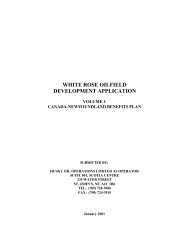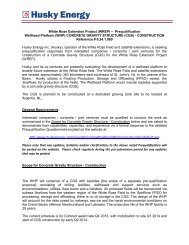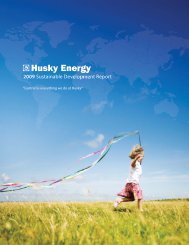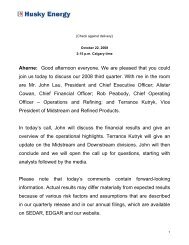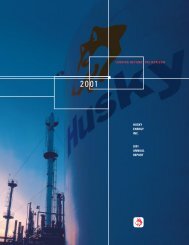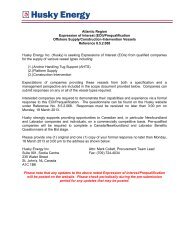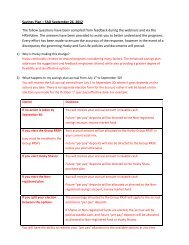white rose oilfield development application - Husky Energy
white rose oilfield development application - Husky Energy
white rose oilfield development application - Husky Energy
- No tags were found...
Create successful ePaper yourself
Turn your PDF publications into a flip-book with our unique Google optimized e-Paper software.
Side scan sonar images of the White Rose area indicate that the surficial geology is a thin veneer of fineto medium grained sand over a coarser substrate, consisting of sand and gravel. Occasional occurrencesof gently-sloped gravel mounds in the area may correspond with old iceberg scour berms.Past interpretations of biota present in seabed photographs have suggested that the seabed is relativelystable, with relatively little sedimentary transport within the region. This is supported by recentmapping exercises within the region. These clearly display anchor marks from old drilling programs,preserved after 15 to 20 years.Additional data of the soil types and characteristics are based upon a series of glory holes that werecompleted in the Grand Banks area for the Terra Nova <strong>development</strong>. From the current state ofgeotechnical and geological knowledge of the Grand Banks, it is reasonable to infer that geotechnicalconditions at the White Rose site will be similar to those at the Terra Nova site.4.4 Production and Export/Transportation System4.4.1 Production SystemThe production concept is a floating, production, storage and offloading ship-shaped vessel. Productionfacilities are mounted on raised supports above the vessel deck. Reservoir fluids pass from subseaproduction wells, via flowlines and risers, up into the turret and then to the production facilities.Produced oil is stored in the vessel cargo tanks and periodically offloaded onto a shuttle tanker via aloading hose.The FPSO hull will be approximately 200 to 300 m in length, 40 to 45 m in breadth and 22 m in depth, icestrengthened,and have a lightship weight of approximately 31,000 t supporting a topside process plantwith a dry weight of approximately 7,300 t. The FPSO will be moored using a geo-stationary turret,which is anchored to the seabed. The turret mooring will be disconnectable to allow the FPSO to moveto avoid iceberg threat. The vessel will rotate (‘weather vane’) around the turret to take up a position ofleast resistance to the ambient conditions, with the bow heading into the prevailing wind and waves.The FPSO will be positioned between the glory holes and will receive production via flowlines thatdeliver reservoir fluids through the turret located near the bow of the vessel. Stabilized oil will be offloadedto a shuttle tanker from the stern of the FPSO via a loading hose. To be conserved, produced gaswill be compressed and reinjected back into the geological formation through the turret via dedicatedflowlines.White Rose DA Project Summary • January 2001 Page 56



